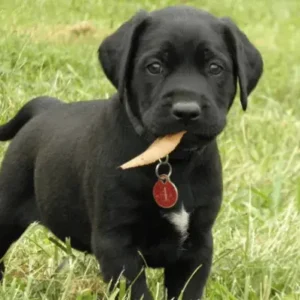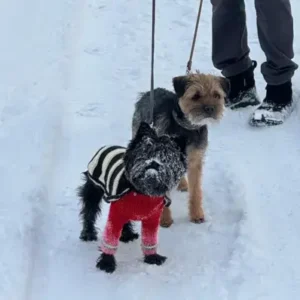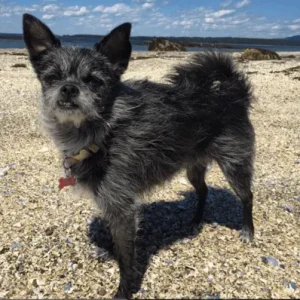Basset Fauve de Bretagne History/Origin
The Basset Fauve de Bretagne, an ancient breed from France, has a rich history dating back to the 16th century. Originating from the now-extinct Grand Fauve de Bretagne, these compact scent hounds were initially bred for hunting small game, particularly rabbits. The name “Basset” refers to their low-to-the-ground stature, while “Fauve” describes their distinctive fawn-colored coat.
Basset Fauve de Bretagne history- Source: AKC.org
Historically, these purebred dogs were owned by French aristocrats who prized them for their excellent hunting abilities. However, following the French Revolution, the breed became more accessible to commoners, who continued to value them for their hunting prowess.
Despite their near-extinction during World War II, dedicated French breeders revived the breed in the 1950s. Today, the Basset Fauve de Bretagne remains popular in France and is gaining recognition in the United States. The American Kennel Club (AKC) included them in the Foundation Stock Service in 2015, classifying them in the Hound Group.
Basset Fauve de Bretagne Personality
Basset Fauve de Bretagne are one of the dog breeds known for their lively and affectionate nature, making them spirited companions for families. With a history rooted in hunting, they possess high energy levels and a love for the outdoors.
- Basset Fauve de Bretagne Temperament
Their intelligence and courage are evident, but they also exhibit a strong independent streak. While they can be sociable, some individuals may show a protective side, although they are not typically considered watchdogs.
- Potential challenges
Basset Fauve de Bretagnes are known for their loving and lively personalities, but sometimes they can be a bit stubborn when it comes to training. This is because they have a strong independent streak, meaning they like to do things their way.
To help with this, it’s important to be patient and use positive training methods. Consistency is key, so practicing regularly and rewarding good behavior will help them learn what you want them to do. With some patience and love, they can become well-behaved and obedient companions.
To keep them happy and well-adjusted, they require daily mental and physical stimulation. Regular walks and runs are essential to maintaining their overall well-being and ensuring they remain in good spirits.
Basset Fauve de Bretagne Physical Appearance
The Basset Fauve de Bretagne is characterized by its low stature, typical of Basset hounds, and a stocky build.
- Basset Fauve de Bretagne Size
The Basset Fauve de Bretagne typically falls into the category of small to medium-sized dogs. They typically stand between 12 to 15 inches (30 to 38 cm) at the shoulder and weigh between 25 to 35 pounds (11 to 16 kg).
Despite being small in size, they have a strong and sturdy build that gives them a solid appearance.
- Coat Color
Basset Fauves can come in various shades of fawn, golden wheaten, or red. These colors may vary in intensity, with some dogs displaying deeper hues than others.
Some might have little black hair on the back of their ears as well. Other than that, their coat is usually of one color, with varying shades.
The coat of the Basset Fauve de Bretagne is of a wiry texture and rough to the touch. This coarse texture provides warmth and protection.
Golden Basset Fauve de Bretagne -Source: AKC.org
Fawn Basset Fauve de Bretagne- Source: bassetfauvedebretagne
Basset Fauve de Bretagne Gender Differences
While both male and female Basset Fauve de Bretagnes share many physical traits and temperaments, there are slight differences.
Males are typically slightly larger and heavier, with some exhibiting more outgoing behavior. Females may be a bit more reserved and nurturing, especially during heat cycles. However, individual personalities vary widely regardless of gender.
Basset Fauve de Bretagne Feed/Nutrition
Basset Fauve de Bretagnes require a balanced diet rich in quality protein and essential nutrients to support their active lifestyle.
Opt for high-quality dog food with real meat as the primary ingredient. Include lean meats, fish like shrimp, fruits like mango, and vegetables like broccoli for variety and essential vitamins. Avoid excessive treats and table scraps to prevent weight gain.
Monitor food intake and provide fresh water at all times. Consult with your veterinarian for personalized dietary recommendations.
Basset Fauve de Bretagne Health
Overall, Basset Fauve de Bretagnes are a healthy breed with few genetic health issues. However, like all breeds, they may be prone to certain conditions such as:
- Progressive Retinal Atrophy (PRA): Progressive Retinal Atrophy is a genetic eye disorder that affects the retina, leading to gradual vision loss and eventual blindness. Symptoms typically start with night blindness and progress to decreased vision in daylight as the disease advances.
- Cardiomyopathy: Cardiomyopathy refers to diseases of the heart muscle, leading to abnormal heart function. In Basset Fauve de Bretagnes, dilated cardiomyopathy is the most common form. Symptoms may include fatigue, weakness, coughing, and difficulty breathing.
- Epilepsy: Epilepsy is a neurological disorder characterized by recurrent seizures. While the exact cause is often unknown, it is believed to have genetic and environmental factors. Seizures can vary in severity and frequency, ranging from mild episodes to severe convulsions.
Basset Fauve de Bretagne Care and Grooming
Basset Fauve de Bretagnes are generally low-maintenance dogs, thanks to their wiry and harsh coat that naturally repels dirt and prevents mats. Weekly brushing is typically sufficient to keep their coat free from tangles and in optimal condition.
While they may not require frequent baths, they should be bathed as needed, particularly if they get into something messy.
Like all dogs, they need regular dental care and nail trimming. Brush their teeth a few times a week and trim their nails to keep them comfortable.
Their floppy ears need special attention too. Clean ears gently with an ear cleaner to prevent infections.
Apart from grooming, make sure they get enough exercise and playtime to stay happy and healthy. Regular walks and fun activities keep them active and entertained. Additionally, house training your dogs is essential for ensuring they develop proper habits and maintain a clean living space.
Basset Fauve de Bretagne Rescue
If you’re thinking of adopting a Basset Fauve, rescue organizations dedicated to this breed exist to help find loving homes for dogs in need.
Basset Fauve de Bretagne Price
The price of a Basset Fauve de Bretagne usually ranges from $800 to $1,200, depending on the breeder and the dog’s lineage.
When considering purchasing a Basset Fauve de Bretagne, it’s crucial to research reputable breeders who prioritize the health and welfare of their dogs. Choose a breeder who conducts health screenings, follows ethical practices, and raises puppies in a clean, nurturing environment with proper socialization.
Interesting Facts
- The Basset Fauve breed comes from its larger ancestors, the Grand Basset Fauve de Bretagne, which has now become extinct.
- This breed has remained a regal and aristocratic choice in France. It was brought to the French court by Admiral d’Anneboulde in 1520.
Best For
Basset Fauve de Bretagnes make good family pets and are well-suited for active individuals or families who enjoy outdoor activities such as hiking and hunting.
Top Names
| Male Basset Fauve de Bretagne Names | Female Basset Fauve de Bretagne Names |
| Gaston | Amélie |
| Pierre | Colette |
| Émile | Fleur |
| Hugo | Sophie |
| Jacques | Violette |









 Basset Fauve de Bretagne history- Source:
Basset Fauve de Bretagne history- Source: 

 Golden Basset Fauve de Bretagne -Source:
Golden Basset Fauve de Bretagne -Source:  Fawn Basset Fauve de Bretagne- Source:
Fawn Basset Fauve de Bretagne- Source: 







